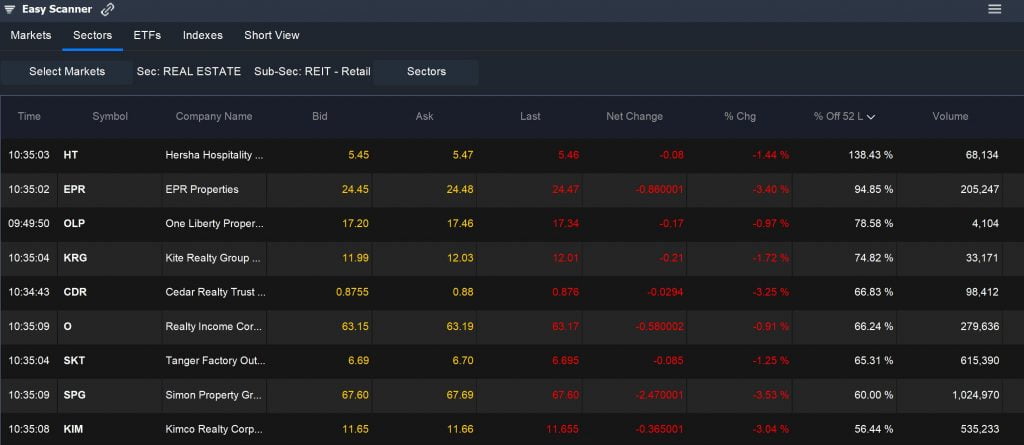Investing in real estate is a good way to diversify your portfolio and move some of your financial risk away from the stock market. Many traders turn to REITs (real estate investment trusts) to easily invest in portfolios of properties.
With hundreds of REITs available in the US, it’s important to be able to quickly sort through companies and find winning opportunities. Today, we’ll explain how to evaluate a REIT and show you how to build a REIT scanner using Scanz.
What are REITs?
REITs, or real estate investment trusts, are companies that own real estate. REITs are similar to mutual funds in that they pool investors’ money to buy an asset. Instead of buying stocks, though, REITs purchase properties or even mortgage debt.
A typical REIT might own a portfolio of several dozen properties, each of which generates revenue through rent. That rental income is then distributed to investors as dividends. In addition, the value of a REIT can increase over time as the value of its holdings grows.
REITs can be traded publicly on the stock exchange, or they can be private investments. If you invest in a private REIT, expect to find a minimum investment amount and rules around how long you must stay invested before you can get your capital back. Many investors prefer publicly traded REITs because they are more liquid. You can also invest in REITs through real estate-focused ETFs.
What to Look for in a REIT
REITs operate somewhat differently than most traditional companies. Instead of producing a product or offering a service, these companies make money by owning properties and renting them out. If you’re new to REIT investing, it’s important to know what factors what to consider when choosing a REIT.
Types of REITs
There are several different types of REITs based on the types of real estate that these companies invest in:
Retail REITs own shopping centers and malls. These make up nearly one-quarter of REITs, and their fate is tied to the fate of the retail industry. Take a close look at what tenants are in a REIT’s properties, especially since the retail sector has been distressed in recent years.
Office REITs own commercial office buildings. Once again, it’s important to consider what tenants are in a REIT’s properties and whether they are likely to stay. It’s also worth thinking about the economic trajectory of the cities that a REIT’s properties are in.
Healthcare REITs invest in hospital buildings, medical offices, rehab centers, and nursing and retirement homes. These REITs are closely intertwined with the US medical system and depend heavily on insurance reimbursements. Healthcare properties are a complex niche, so make sure that a REIT has plenty of experience with this type of real estate.
Residential REITs own single- and multi-family homes and apartment buildings. This sector has been extremely hot in recent years, especially for companies that own properties in regions where the cost of housing is high (e.g. California and New York). Residential REITs succeed when more people are renting rather than buying their own homes, and when the population of an area is increasing.
Mortgage REITs invest in mortgages rather than properties themselves. They generate revenue from loan repayments and interest. Mortgage REITs lose value when interest rates go up, so carefully consider national economic conditions before investing in this type of company.
Dividends and Appreciation
REITs generate returns in two ways: through dividends and through share price appreciation. How much money a REIT pays out in dividend each year varies widely among companies. Some choose to distribute the majority of profits, while others keep a significant amount of profit to reinvest in new properties.
When choosing a REIT, consider what balance of fixed income and exposure to a changing stock price you desire.
Management Team
While the management team at any company is important, it’s especially crucial for REITs. Look for companies that are managed by an expert team that has years of experience in the market niche the REIT occupies. The longer a company has been around, the more likely it is to have a strong foothold in its area and an economy of scale when it comes to managing its properties.
How to Build a REIT Scanner
The easiest way to find the right REIT for you is to use the Easy Scanner module in Scanz. You can scan for REITS by selecting ‘Real Estate’ under the ‘Sectors’ menu. The Easy Scanner also enables you to further narrow your search to different real estate sub-sectors like ‘REIT-Office’ and ‘REIT-Retail.’

Once your real estate scan is set up, you can adjust the scanner view to find REITs that are of interest. Sort by % Change to see what REITs are posting big price movements on the day. Or, use % Off 52 Low to see what REITs have posted a significant gains over the past year.

It’s also a good idea to check on the trading volume around a REIT. You can sort REITs by Volume and add a column for x10 ADV to see how the day’s volume compares to the 10-day average volume. Avoid REITs that are trading with low volume, since low liquidity makes it hard to open and close your position.

Once you’ve found a prospective REIT, you can inspect it more closely using the Montage module. Here, you can inspect and analyze the technical chart using a variety of indicators. The Montage also includes news headlines around that REIT, which may give more insight into recent price movements.

Conclusion
Investing in REITs offers a way to diversify your portfolio while getting exposure to a wide range of real estate holdings. REITs typically offer both dividend yield and price appreciation, but it’s important to consider whether a specific company focuses more on investor payouts or reinvestment in new properties. With Scanz, it’s easy to find high-performing REITs in any subsector so you can start investing in real estate.








